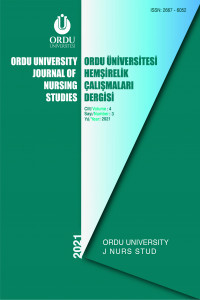Hemşirelik Eğitiminde Öğrencinin Akademik Edinimleri: Farmakolojik ve Etik Bakış Açısından Bir Değerlendirme
Advers ilaç reaksiyonlarının raporlanması hemşirelerin sorumluluklarındandır. Diğer ülkelere kıyaslandığında, ülkemizdeki advers ilaç reaksiyonlarını raporlama oranları hala ortalamanın altındadır. Bu derlemede amaç, ders programındaki farmakovijilansın ve materyovijilansın önemi hakkında farkındalık oluşturmak ve yükseköğretimdeki hemşirelik akademisyenlerinin rolünün altını çizmektir. Ayrıca advers etki ve tıbbi cihaza bağlı olay raporlanmasını, kişisel bakım ürünleri ve farmasötiklerin güvenli atılımını artırmak ve “second victim” fenomeni hakkında farkındalık yaratmaktır. Bu makalede, hemşirelik eğitimcilerinin rolleri ve sorumlulukları, ders programına yönelik öneriler farmakoloji eğitiminin temellerine dayanmaktadır.
Anahtar Kelimeler:
Pharmacovigilance, materiovigilance, second victim, nursing
Student Academic Gains In Nursing Education: An Evaluation From Pharmacological and Ethical Point of View
Adverse drug reaction (ADR) reporting is a responsibility of nurses, ADR reporting in Turkey is still below the average when compared to other countries. The aim of this review is to raise an awareness of importance of pharmacovigilance materiovigilance in curriculum and to underlie the role of nursing academics in higher education. In addition, it is aimed to promote nurses effective ADR and medical device reaction reporting, and also safe disposal of pharmaceuticals and personal care products and raise awareness of second victim phenomenon. In this article the roles and responsibilities of nursing educational practitioners and curricular recommendations are based on the principles of pharmacology education.
Keywords:
Pharmacovigilance, materiovigilance, second victim, nursing,
___
- REFERENCES Angamo MT, Chalmers L, Curtain CM, Bereznicki LRE. (2016) Adverse drug reaction related hospitalisations in developed and developing countries: a review of prevalence and contributing factors. Drug safety 39(9):847–57.
- Aydınkarahaliloğlu ND, Aykaç E, Atalan Ö, Demir N, Hayran M (2018) Spontaneous Reporting of Adverse Drug Reactions by Consumers in Comparison with Healthcare Professionals in Turkey from 2014 to 2016. Pharmaceutical Medicine 32:353–364
- Council of Higher Education electronic database (2015). http://www.osym.gov.tr/belge/1-19213/2012-2013-ogretim-yili-yuksek-ogretim-istatistikleri.html. (Erişim 15.06.2015). Guides of Student Selection and Placement Center (2015) http://dokuman.osym.gov.tr/pdfdokuman/2015/YGS/2015_OSYS_KILAVUZ.pdf. (Erişim 15.06.2015). Edrees H, Connors C, Paine L, Norvell M, Taylor H, Wu AW (2016). Implementing the RISE second victim support programme at the Johns Hopkins Hospital: a case study. BMJ Open. Sep 30;6(9):e011708.
- Frenk J, Chen L, Bhutta ZA (2010). Health professionals for a new century: Transforming education to strengthen health systems in an interdependent world. Lancet; 376: 1923–1958.
- Kohn L, Corrigan J, Donaldson M. (2000) To Err is Human: Building a Safer Health System. National Academy Press.
- Leendertse AJ, Egberts ACG, Stoker LJ, van den Bemt PMLA. (2008). HARM Study group. Frequency of and risk factors for preventable medication related hospital admissions in The Netherlands. JAMA Internal Medicine,168(17),1890–6.
- Institute of Medicine (US) Committee on the Work Environment for Nurses and Patient Safety; Page A, editor.Washington (DC): National Academies Press (US); 2004. Keeping Patients Safe: Transforming the Work Environment of Nurses.
- Makary MA, Daniel M. (2016) Medical error-the third leading cause of death in the US. BMJ, 353:i2139.
- National Nursing Core Training Program framework (2014) (HUÇEP-2014) Erişim tarihi: 14.03.2019,http://www.hemed.org.tr/index.php?option=com_content&task=view&id=547&Itemid=178
- Pirmohamed M, James S, Meakin S, Green C, Scott AK, Walley T, Farrar K, Park BK, Breckenridge AM. (2004) Adverse drug reactions as cause of admission to hospital: prospective analysis of 18820 patients. BMJ, 329(7456), 15–9.
- Scott SD, Hirschinger LE, Cox KR, McCoig M, Brandt J, Hall LW. (2009) The natural history of recovery for the healthcare provider ‘second victim’ after adverse patient events. BMJ Quality & Safety, 18(5), 325-330.
- T.C. Sağlık Bakanlığı Sağlık İstatistikleri Yıllığı (2017) Sayfa 217
- TMMDA (2002a). Relevant Turkish Legislation: Directive on Medical Devices published in Official Journal numbered 24694 and dated 13.03.2002
- TMMDA (2002b) Relevant Turkish Legislation : Directive on Active Implantable Medical Devices published in Official Journal numbered 24693 and dated 13.03.2002 TMMDA 2003.
- TMMDA (2003) Relevant Turkish Legislation: Directive on In Vitro Diagnostic Medical Devices published in Official Journal numbered 25259 and dated 14.10.2003. https://www.titck.gov.tr, Dosyalar/Erisim/TMMDABrochure.pdf Erişim Tarihi: 14.03.2019
- TMMDA (2014a) Turkish Drug and Medical Device Agency Regulation on safety of drugs.
- TMMDA (2014b) Turkish Drug and Medical Device Agency (2014) Good Pharmacovigilance Practices. Erişim tarihi 14.03.2019 https://www.titck.gov.tr/faaliyetalanlari/ilac/farmakovijilans
- World Health Organization (2009). Global standards for the initial education of professional nurses and midwives. Geneva: WHO.
- World Health Organization (2010).WHO consultation on the transformative scale-up ofmedical, nursing andmidwifery education. Second technical reference group meeting: Nursing and midwifery education experts 15–16 July 2010. Geneva: WHO.
- WHO, The Importance of Pharmacovigilance-Safety Monitoring of Medicinal Products (2002), p. 1-14.
- Wu AW (2000). Medical error: The second victim. The doctor who makes the mistake needs help too. British Medical Journal, 320 (7237), 726–727.
- Yayın Aralığı: Yılda 3 Sayı
- Başlangıç: 2018
- Yayıncı: Ordu Üniversitesi
Sayıdaki Diğer Makaleler
Esra TÜRKER KÜÇÜKYILMAZ, Ayşe Gül ATAY DOYĞACI, Nilay BEKTAŞ AKPINAR
Hemşirelik Öğrencilerinin Tıbbi Atık Yönetimine İlişkin Bilgi Düzeyleri
Nuray TURAN, Gülsün ÖZDEMİR AYDIN, Hatice KAYA, Türkinaz ATABEK AŞTI, Gayenur AKSEL, Arzu YILMAZ
İlk ve Acil Yardım Programı Öğrencilerinin Yaz Stajı Hakkındaki Görüşlerinin İncelenmesi
Hatice DEMİRAĞ, Sevilay HİNTİSTAN
Hemşirelik Eğitiminde Farmakovijilansın ve Ekofarmakovijilansın Önemi
İç Hastalıkları Hemşireliği Dersini Alan İkinci Sınıf Öğrencilerinin Stres Düzeylerinin Belirlenmesi
Aysun CAN, Burcu ÇUVALCİ, Sevilay HİNTİSTAN
Üniversite Öğrencilerinin Toplumsal Cinsiyet Rolleri Tutumları ve Yaşam Değerleri Arasındaki İlişki
